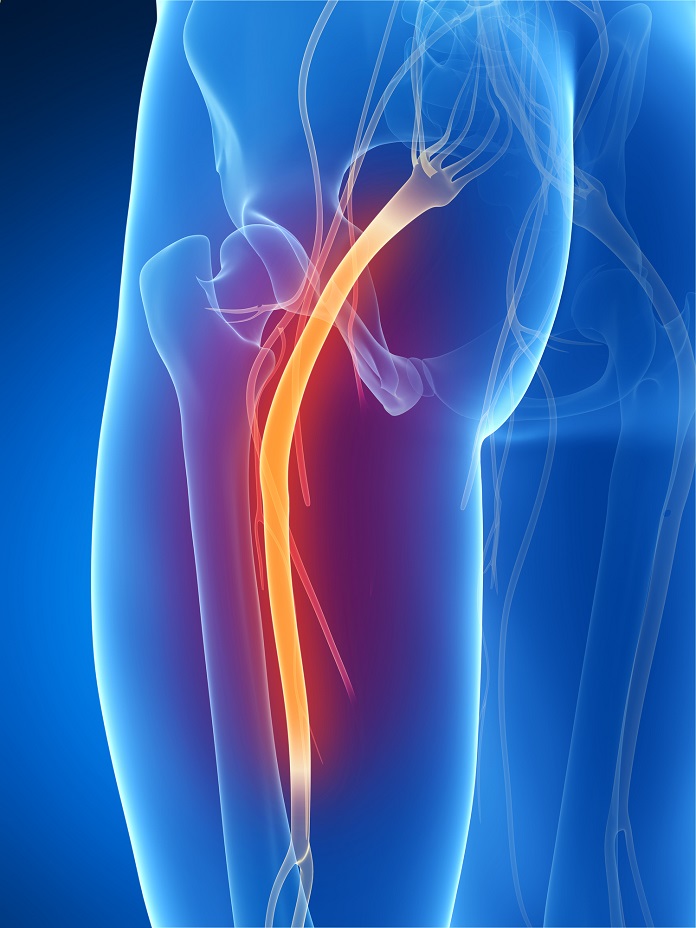Ever felt deep pain ripping down the back of your legs, perhaps with numbness and tingling that extends down to your foot? It could just be aches, pins and needles from sleeping or sitting in an uncomfortable position, or it could be a sign of sciatica. But what is sciatica and how can you tell if you have it?
Most people have at least one episode of sciatica during their lives, yet few of us know how to tell if leg pain is a potentially serious nerve-related issue, or just muscle ache from sitting at a desk all day or overdoing it at the gym.
We asked some medical experts to clear up the confusion and explain more about the potential symptoms, causes and treatments of this common pain condition.
What is sciatica?
“Sciatica is a condition characterised by pain running down the back of the leg, usually from the lower back,” explains physiotherapist Dirk Laubscher. “It is the name given to any sort of pain caused by irritation or compression of the sciatic nerve, which is the longest nerve in your body.”
The sciatic nerve runs from the back of your pelvis, through your buttocks, and all the way down both legs, ending at your feet. This is why it’s common to feel sciatic pain throughout the lower part of the body, although often it’s just one leg that’s affected.

What are the symptoms?
One of the most obvious symptoms of sciatica is pain. The pain can range from mild to very severe, making it difficult to do basic daily activities or find a comfortable position.
Dirk explains that it can be common for people with sciatica to experience numbness and tingling/pins and needles that travels from the lower back and moves down one of your legs to your foot. You may also feel weakness in the calf muscles and the muscles that move the foot and ankle.
“The pain can range from being mild to extremely painful, and may be made worse by sneezing, coughing or sitting,” explains Dirk. “This pain can be quite debilitating.”
What causes sciatica?
A number of things can cause sciatica pain. Dr Sarah Brewer, GP and medical director at Healthspan, says: “One of the usual causes of sciatica is a ‘slipped’ intervertebral disc. This presses on the root of the sciatic nerve where it joins the spinal cord.”
A ‘slipped’ disc usually occurs when one of the discs that lay between the bones of the vertebrae is weakened or damaged, or bulges outwards from the spinal column. Bulging discs are actually very common and do not always cause symptoms, so your GP might not automatically refer you for scans.
Sciatica can also be triggered by other medical conditions, such as as arthritis, spinal tumours and blood clots. It can also be common during pregnancy due to postural changes. Sometimes, there can be muscular causes too, if severe tightness is pinching or irritating a nerve.

How can you treat sciatica?
Most people find their sciatica symptoms go away naturally within in a few weeks. But some cases can last for a year or more. Whether you’re suffering for days or months, there are a few things you can do to help.
Book in with your GP
If you suspect you have sciatica, it’s a good idea to seek medical advice. Your doctor will chat through your history, and depending on the severity and pattern of your symptoms, they may decide to wait and see what happens. They may suggest exercises and lifestyle changes that might help, or advise on pain relief.
Sometimes, they might refer you for a full neurological examination and/or scans. “If necessary, a GP might give you an MRI scan to help assess where damage is occurring and identify any prolapsed discs,” says Dr Brewer.
Treatment varies depending on the severity and can range from painkillers and bed rest to spinal surgery.
Find a physio
“Physiotherapy is great for the treatment of sciatica,” says Dirk. A specialist can show you a combination of stretches and strengthening exercises that can help to relieve symptoms and strengthen the spinal column and core.
However, Dirk strongly advises that you check your physiotherapist has experience with the spine and the sciatic nerve before undergoing treatment.

Go hot and cold
“For acute sciatic pain, ice and heat packs are readily available and can help alleviate the leg pain, especially in the early phase,” says Dirk.
He suggests applying ice or heat is for approximately 15-30 minutes, repeating the process every two hours. “Most people use ice first,” he says, “but some find more relief with heat.” It’s best to apply ice with a towel placed between the ice and skin to avoid ice burn.
Take up yoga or Pilates
Yoga and Pilates can help gently stretch the muscles and joints and strengthen your back and buttocks to help reduce recurrences of back pain or sciatica.
However, if your symptoms are severe or acute – or if you have been diagnosed with a disc injury – always seek advice from your doctor or physio before embarking on any new exercise regime as you could risk making symptoms worse.
Basic foundational asanas, like standing poses and downward dog, can help align, lengthen and strengthen your lower back. Spinal twists, hip openers and hamstring stretches can also help. It’s best book into a restorative yoga class in your area rather than attempting to stretch unsupervised. Speak to your instructor about your injuries and they’ll be able to help safely guide your practice.

Try a herbal remedy
“Devil’s claw is a great traditional remedy for lower back pain,” says Dr Brewer. A plant that’s native to the deserts of South and Southeast Africa, you can buy it in tincture or capsule form. You can buy Natures Aid JointEeze Devil’s Claw on Amazon.
Studies have found that extracts from the root can block several pathways which cause joint inflammation. This could help to relieve pain associated with sciatica.
You may also be interested in…
This article may include affiliate links to products and services where we may receive a small fee to support the running of this site if you make a purchase or is a sponsored article from one of our select editorial partners providing valuable advice and information to our readers.
































































